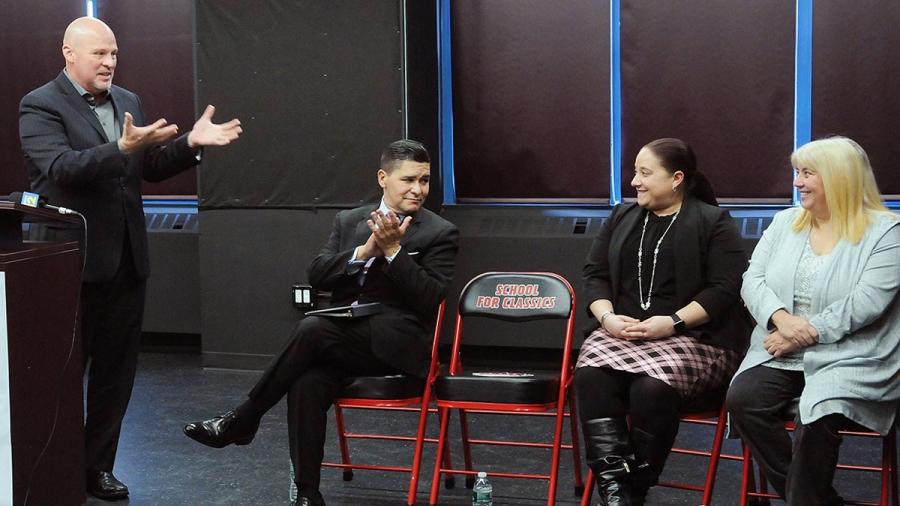
UFT President Michael Mulgrew (standing), with Schools Chancellor Richard Carranza, acknowledges School for Classics HS Principal Nicole Tancredi (second from right) and Chapter Leader Donna Limoli during a press conference announcing a new round of Bronx Collaborative Schools Plan applications.
The Bronx Collaborative Schools Plan, which successfully launched with 50 schools last year, is now expanding to include 70 additional schools.
Negotiated as part of the 2018 DOE-UFT contract, the Bronx Plan is a joint initiative of the city Department of Education and the UFT that empowers educators to drive changes at their school that meet the specific needs of their school community. It is open to historically underserved schools across all five boroughs.
Launched in early 2019, the initiative will ultimately grow to include up to 180 schools by the third year.
UFT President Michael Mulgrew and Schools Chancellor Richard Carranza announced the opening of the application period at a Dec. 18 press conference at the School for Classics HS in East New York, Brooklyn, one of the first schools selected for the program.
“Everyone thought we were crazy when we signed the collective bargaining agreement that included the Bronx Plan,” said Mulgrew. “We made a bet on the students, the staff and the schools and that appears to have been a smart bet.”
The Bronx Plan requires collaboration among the principal, the UFT chapter leader and the entire school community to create a plan to meet their school’s specific challenges.
Both School for Classics HS Principal Nicole Tancredi and Chapter Leader Donna Limoli attended the press conference, where Mulgrew thanked Limoli for “making us look good.”
Limoli, who admitted she was initially skeptical of the plan, said she would advise would-be applicants to go for it. “You have to talk about what’s important and work with your principal,” she said. “You both want what’s best for the kids.”
Once a school is accepted into the Bronx Plan, a committee of six to 12 members (half appointed by the principal and half chosen by the chapter leader) develops a plan to improve school climate.
Classics HS was one of the schools that benefited from $13 million in facilities upgrades earmarked for Bronx Plan Schools; it used its portion of the funding to create a black box theater.
Additional funding enabled the school to offer seven teachers a $7,200 salary differential for hard-to-fill vacancies. Across the first group of 50 schools, 500 teachers, school counselors and school psychologists are receiving the differential, which is helping to recruit and retain staff and has fueled a decrease of more than 50% in total vacancies in these schools this school year.
Carranza said the Bronx Plan is not a “silver bullet” and participants need to roll up their sleeves. But “we’re creating a culture of change,” he said. “We’ve got your back, and we’ll clear the road for your plan.”